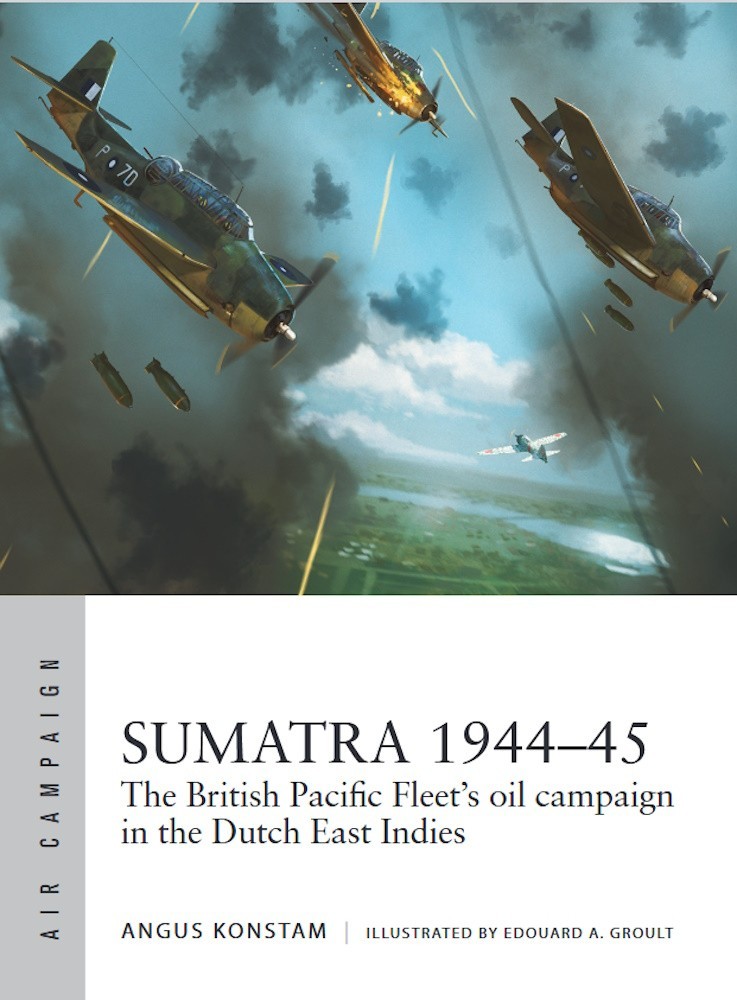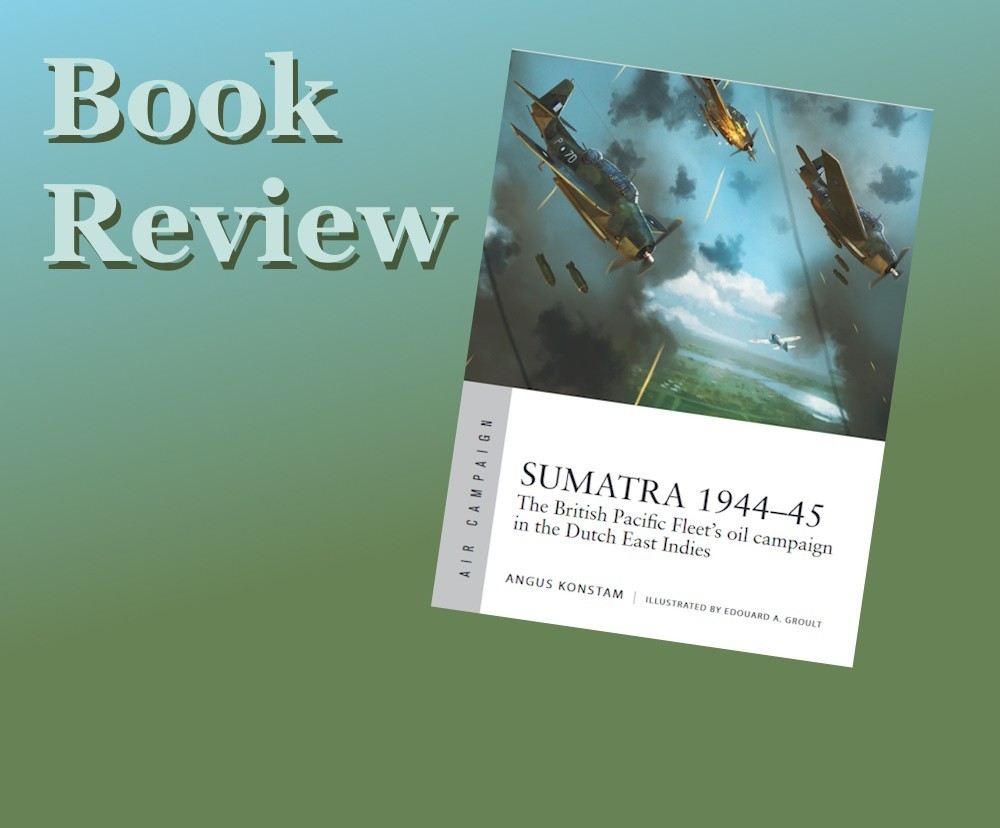
Introduction
Sumatra 1944–45 The British Pacific Fleet’s oil campaign in the Dutch East Indies from Osprey Publishing recounts the Royal Navy’s attempts to destroy Japan’s oil lifeline at the source. Authored by Angus Konstam and illustrated by Edouard Groul, this book in the Air Campaign series is 96 pages in length including front and back content. Formats available are softcover, eBook, Mobi and ePub. The softcover is catalogued with IBSN 9781472862419, and Osprey’s short code ACM 49. The softcover MSRP is $25 USD and the digital copies are $20. Osprey's site provides the following:
- Published Oct 22 2024
- Format Paperback
- Edition 1st
- Extent 96
- ISBN 9781472862419
- Imprint Osprey Publishing
- Illustrated throughout with 65 photos and 16 pages of colour illustrations
- Dimensions 10 x 7 inches
After the Japanese raids into the Indian Ocean in 1942, the British Eastern Fleet was too badly bruised for offensive operations against the Japanese, and Royal Navy operations in the North Atlantic and Mediterranean left little to send east. Two years later things were changing and as Osprey writes of this book:
With the war in Europe in its final stages, by 1944 the Royal Navy was able to put together a major force to join the campaign against Japan. The British Pacific Fleet was arguably the most powerful fleet the Royal Navy has ever sent into action.
Modelers should find plenty of source material to inspire modeling subjects and accurate colors and markings. Let’s launch into the book.
Content
Sumatra 1944–45 is told through over 90 pages in nine chapters and sections:
Eight pages open the book describing the British disasters of 1942 and their slow reorganization and rebuilding for Admiral Somerville to take the fight to Japan.
Per the Air Campaign format the first two chapters are Attacker's Capabilities and Defender's Capabilities, exploring and explaining The British Pacific Fleet and The Japanese in Sumatra. These discuss topics such as;
- British armoured flight deck aircraft carriers
- New carrier aircraft
- ‘Fast carrier’ operations
- Japanese military administration in Sumatra and control of infrastructure
- Japanese Navy’s 2nd South Fleet, and Rengo Kantai (‘Combined Fleet’)
- Japanese anti-aircraft defences including the Type 88 75mm Tai-ku Ko-Sha Ho Hei (‘high-angle anti-aircraft guns’)
- Air defences.
Air defenses discusses the complex organization of Japanese air units from the Kogu gun (‘Air Army’) through the Hikoati (‘Squadron’), and the aircraft types defending Sumatra.
Next, Campaign Objectives points out the dependency of Japan on Indonesian oil, the British introduction to massed fast carrier operations, and how to cut Japan's oil lifeline. The main topic is the 65 pages of The Campaign, "The Royal Navy finally strikes back". It covers the campaign's offensives including Operation Cockpit, Operation Transom, Operation Pedal, Operation Crimson, Operation Banquet, Operation Light, Operation Millet, Operation Robson, and Operation Lentil. Each operation receives an overview of its origins, objectives, execution, and results and lessons learned. An order of battle table is included with some operations. Herein we find accounts of attacks and fights, such as the crews expressing their terror at flying around and under the tethering cables of barrage balloons.
One interesting aspect of the British Pacific Fleet is that it was not solely United kingdom, with Free French and Dutch forces participating in an entirely Allied effort. Throughout we learn of the strengths and weaknesses of different British war machines. Refuelling at Sea (RAS) was uncommon for the Royal Navy but necessary for the big league of the Pacific. Britain had a couple of newer British aircraft come aboard their carriers, Seafires and Fairey Fireflies - good aircraft - but their range was for Europe and not suitable for the vastness of the Pacific. Fortunately, American Grummans and Corsairs were plentiful enough to equip the Fleet Air Arm (FAA) with effective offensive aircraft. The United States Navy sent the aircraft carrier Saratoga to work with the Eastern Fleet and the British learned quickly. Japan sowed the wind in 1941 and early '42, and in 1944-45 the British Eastern/Pacific Fleet was the whirlwind that ravaged the Japanese from Sumatra through Okinawa, to Japan itself. When one considers the massive air attacks the Japanese Fleet had to contend with at the time, reading of Japanese air opposition against the British fleet seems satirical.
Just as the Americans learned with their carrier raids in 1942 leading up to the battles of Coral Seas and Midway, and the Solomons campaign, the British learned and the author recounts their experiences. Growing pains included lack of immediate post-strike assessment for the fleet commander, criticism by free-wheeling USN pilots about the inflexibility of British crews to seek targets of opportunity, and no British planning for a follow-up strike despite that being a standard operating procedure for USN. In addition, the Fairey Barracuda multi-role strike aircraft was found to be not as good as the Grumman Avenger.
As impressive as the book is, there are a few typos and misidentifying aircraft, which some readers may find either de minimis or exasperating, e.g., misidentifying the F6F Hellcat as both a "Hellfire" and "Helldiver", misspelling the company name of the "Vaught" F4U Corsair, and mentioning a Ki-45 twin-engine fighter but showing an A6M Zero. A photograph of "1944" Seafires on deck are of post-war Seafire Mk.XVIs.
This book opened my eyes to these naval actions of which I was quite ignorant. The final three pages of Analysis and Conclusion sums up the progress of turning the RN's carrier arm into a strategic force against the Japanese.
Photographs, Graphics, Illustrations
Readers might ask whether this book has relevance or benefit for modelers, and my reply is an enthusiastic "yes." The aircraft, naval vessels, and attack images provide a rich source of material for our hobby, and definitely provide inspiration for building models of planes, ship, and deck scenes with a solid understanding of the conflict. For instance, what do you think of preshading aircraft? Whether you think it creates a superior finish or is ridiculous, images of the aircraft will support whichever modeling technique you prefer. I admit that I have not been very interested in Fleet Air Arm American aircraft because I associated them with the European war, but FAA aircraft over the Pacific have sparked in me a new interest in the subject.
The text is well supported with imagery. I do not recall any color photographs. However what the cameras of the day missed, the artists and illustrators splash color and unique vantage points to enhance the visual content. There are quite a few photos that I've seen before, and plenty that are new to me. A selection I find notable are:
- HMS Indomitable in an USN ship camouflage measure
- Choreographed chaos of refuelling and arming of a Grumman Avenger
- A fragile Seafire stranding on its dislocated nose on a carrier deck
- A tough Corsair's badly damaged stabilizer admired by the pilot.
Most are high quality. Many photos taken from aircraft during an attack cannot always be expected to be studio quality. Regardless, I did not see a single photograph that did not provide me with something good to look at. Each photograph is accompanied by captions of various length, and some of them provide quite a bit of a narrative. I especially appreciate all the maps.
Maps
1. Original boundary of South-East Asia Command (SEAC), from 70E° to 120°E and 30°N to 40°S, showing Japanese Navy ports and Royal Navy ports.
2. Japanese-Occupied Sumatra 1944–45, displaying airfields and oil refineries.
3. Operation Transom: The Strike on Surabaya, 17 May 1944.
4. Operation Crimson: The Strike on Sabang, 25 July 1944.
5. Pladjoe Oil Refinery, Palembang, targets.
Illustrations and Graphics
1. The Air Defences of Palembang, Sumatra, January 1945.
2. Order of Battle, The British Pacific Fleet, November 1944.
3. Action scene: Operation Crimson: the strike on Sabang, 25 July 1944, showing a Corsair strafing Zeros.
4. Action scene: Operation Lentil: strike on Pangkalan Brandan, 4 January
1945, showing Fireflys salvoing rockets.
5. Action scene: Operation Meridian I: strike on Pladjoe Refinery, Palembang, 24 January 1945: TBF Avengers dive-bombing through flak.
6. Two-page bird's-eye illustration Operation Robson, 20 December 1944, The air strike on Belawan Deli, keyed to eight events.
7. Two-page bird's-eye illustration Operation Meridian, 24 January 1945, the air strike on Pladjoe Refinery, Palembang, keyed to 12 events.
8. Orders of Battle for two operations include:
- Operation name
- Fleet involved and commander
- Ships, e.g., Aircraft Carriers, Battleships, Battlecruiser, Heavy Cruisers, Light Cruisers, Destroyers
- Air forces involved by number and units, e.g., 57 strike aircraft, 61 escort (118 aircraft), by type:
Escorts; Strike Aircraft.
A fine selection of combat, operational, representational, and inspirational imagery is provided for the reader.
Page showing order of battle table
Intense combat narrative, and diorama potential
Representive half-page of bird's-eye map
Action illustration, half of the scene
Good reference material
Map example
Combat view of an attack
Conclusion
Sumatra 1944-45 is another worthwhile title from Osprey in there series Air Campaign. Information the author presents, plus the visual elements of photos, artwork and graphics, all work together to create a great deal of understanding and interest of that phase of the Pacific war. I believe that this book is worthwhile for the bookcases of modelers of the Pacific Fleet, Fleet Air Arm aircraft, Royal Navy combat ships, the Pacific war, and fast carrier operations. Recommended.
Thanks to Osprey for providing this book for review. Please remember to mention to them and to retailers that you saw this review here - on Aeroscale.

